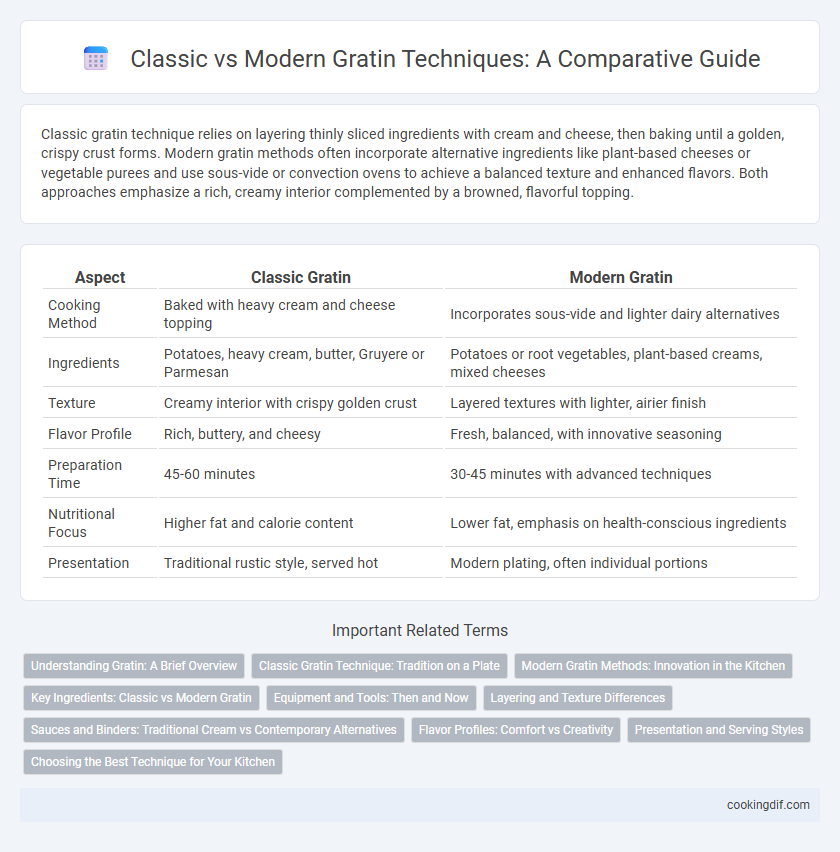Classic gratin technique relies on layering thinly sliced ingredients with cream and cheese, then baking until a golden, crispy crust forms. Modern gratin methods often incorporate alternative ingredients like plant-based cheeses or vegetable purees and use sous-vide or convection ovens to achieve a balanced texture and enhanced flavors. Both approaches emphasize a rich, creamy interior complemented by a browned, flavorful topping.
Table of Comparison
| Aspect | Classic Gratin | Modern Gratin |
|---|---|---|
| Cooking Method | Baked with heavy cream and cheese topping | Incorporates sous-vide and lighter dairy alternatives |
| Ingredients | Potatoes, heavy cream, butter, Gruyere or Parmesan | Potatoes or root vegetables, plant-based creams, mixed cheeses |
| Texture | Creamy interior with crispy golden crust | Layered textures with lighter, airier finish |
| Flavor Profile | Rich, buttery, and cheesy | Fresh, balanced, with innovative seasoning |
| Preparation Time | 45-60 minutes | 30-45 minutes with advanced techniques |
| Nutritional Focus | Higher fat and calorie content | Lower fat, emphasis on health-conscious ingredients |
| Presentation | Traditional rustic style, served hot | Modern plating, often individual portions |
Understanding Gratin: A Brief Overview
Gratin techniques vary between classic and modern approaches, with classic gratins featuring layers of thinly sliced potatoes baked in cream and topped with golden, toasted cheese for a rich, creamy texture. Modern gratin methods often incorporate alternative ingredients such as root vegetables, cauliflower, or even plant-based creams, emphasizing lighter, healthier variations while maintaining the signature crispy crust. Understanding these differences highlights the evolution of gratin from a traditional French comfort dish to a versatile, contemporary culinary creation.
Classic Gratin Technique: Tradition on a Plate
Classic gratin technique emphasizes layering thinly sliced potatoes with cream and cheese, often Gruyere, before baking to achieve a golden, crispy crust and tender interior. This traditional method relies on slow cooking to develop rich, complex flavors and a creamy texture that melts in the mouth. Maintaining precise temperature control ensures the perfect balance between a crunchy topping and a luscious, smooth base.
Modern Gratin Methods: Innovation in the Kitchen
Modern gratin methods emphasize innovative techniques such as using sous-vide cooking to achieve precise texture and flavor infusion, as well as incorporating plant-based cheeses for enhanced dietary options. The introduction of dehydrated vegetable powders and molecular gastronomy elements allows chefs to create gratins with unique flavor profiles and visually striking presentations. These advancements in the kitchen optimize cooking time and elevate the classic gratin into a versatile, health-conscious dish suitable for contemporary palates.
Key Ingredients: Classic vs Modern Gratin
Classic gratin relies on key ingredients like heavy cream, Gruyere cheese, and breadcrumbs to create a rich, crispy topping and creamy interior. Modern gratin techniques often incorporate lighter alternatives such as Greek yogurt or bechamel sauce, combined with diverse cheeses like Parmesan or fontina for enhanced flavor profiles. Both methods emphasize thinly sliced potatoes or vegetables, but ingredient variations significantly influence texture and taste.
Equipment and Tools: Then and Now
Classic gratin techniques relied heavily on heavy ceramic or cast-iron gratin dishes and manual gratinee tools such as hand-held gratin knives for scoring and a simple broiler or open flame for browning. Modern gratin preparation utilizes advanced non-stick metal pans, precision mandolines for uniform slicing, and high-powered ovens with programmable broil settings or integrated salamander burners to achieve consistent melts and crusts. Innovations in thermometers and laser-guided browning sensors also allow chefs to monitor temperature and caramelization levels more accurately, enhancing texture and flavor.
Layering and Texture Differences
Classic gratin techniques emphasize even layering of thinly sliced potatoes or vegetables, resulting in a uniformly tender texture with a golden, crispy crust formed by grated cheese and breadcrumbs. Modern gratin methods experiment with varied layering thickness and incorporate alternative ingredients like root vegetables or creamy purees, creating textural contrasts between soft, creamy interiors and crunchy, caramelized tops. The balance between moisture content and precise baking time is crucial in both approaches to achieve the signature gratin texture.
Sauces and Binders: Traditional Cream vs Contemporary Alternatives
Classic gratin techniques rely heavily on rich cream as the primary sauce and binder, creating a smooth, luscious texture that enhances the dish's golden crust. Modern gratin recipes often substitute cream with alternatives like bechamel sauce, plant-based milks, or cheese blends to accommodate dietary preferences and introduce new flavor profiles. These contemporary binders maintain the gratin's signature cohesiveness while offering lighter or dairy-free options without compromising the dish's comforting richness.
Flavor Profiles: Comfort vs Creativity
Classic gratin relies on rich, creamy bechamel and toasted breadcrumbs, delivering a comforting, familiar flavor profile rooted in tradition. Modern gratin techniques often incorporate innovative ingredients like exotic cheeses, fresh herbs, and unique spices, crafting bold, creative tastes that elevate the dish beyond its rustic origins. Emphasizing texture contrast and umami depth, contemporary gratins balance indulgence with adventurous flavor combinations.
Presentation and Serving Styles
Classic gratin techniques emphasize a golden, crisp crust achieved through traditional broiling, often served directly in the baking dish for rustic presentation. Modern gratin styles incorporate innovative plating with layered ingredients, using ramekins or individual portions to enhance visual appeal and portion control. Presentation increasingly highlights contrasting textures and garnishes like fresh herbs or microgreens to elevate the serving experience.
Choosing the Best Technique for Your Kitchen
Classic gratin technique involves layering thinly sliced ingredients with cream and cheese, then baking until golden and bubbly, offering a rich, comforting texture ideal for traditional kitchens. Modern gratin methods often incorporate lighter ingredients, alternative cheeses, and innovative baking tools like air fryers or convection ovens to achieve a crispier crust with less fat. Selecting the best technique depends on kitchen equipment availability, desired flavor intensity, and nutritional preferences.
Classic vs Modern gratin technique Infographic

 cookingdif.com
cookingdif.com